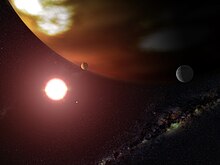Gliese 876 b
Gliese 876 b was initially announced by Geoffrey Marcy on June 22, 1998 at a symposium of the International Astronomical Union in Victoria, British Columbia, Canada.
Since the planet has only been detected indirectly through its gravitational effects on the star, properties such as its radius, composition, and temperature are unknown.
Assuming a composition similar to Jupiter and an environment close to chemical equilibrium, it is predicted that the atmosphere of Gliese 876 b is cloudless, though cooler regions of the planet may be able to form water clouds.
[7] As a result, the orbital elements of the planets change fairly rapidly as they dynamically interact with one another.
[16] Gliese 876 b currently lies beyond the outer edge of the habitable zone but because Gliese 876 is a slowly evolving main-sequence red dwarf its habitable zone is very slowly moving outwards and will continue to do so for trillions of years.
Therefore, Gliese 876 b will, in trillions of years time, lie inside Gliese 876's habitable zone, as defined by the ability of an Earth-mass planet to retain liquid water at its surface, and remain there for at least 4.6 billion years.
[17] While the prospects for life on a gas giant are unknown, large moons may be able to support a habitable environment.
[25] To support an Earth-like atmosphere for about 4.6 billion years (the age of the Earth), the moon would have to have a Mars-like density and at least a mass of 0.07 ME.
[26] One way to decrease loss from sputtering is for the moon to have a strong magnetic field that can deflect stellar wind and radiation belts.


